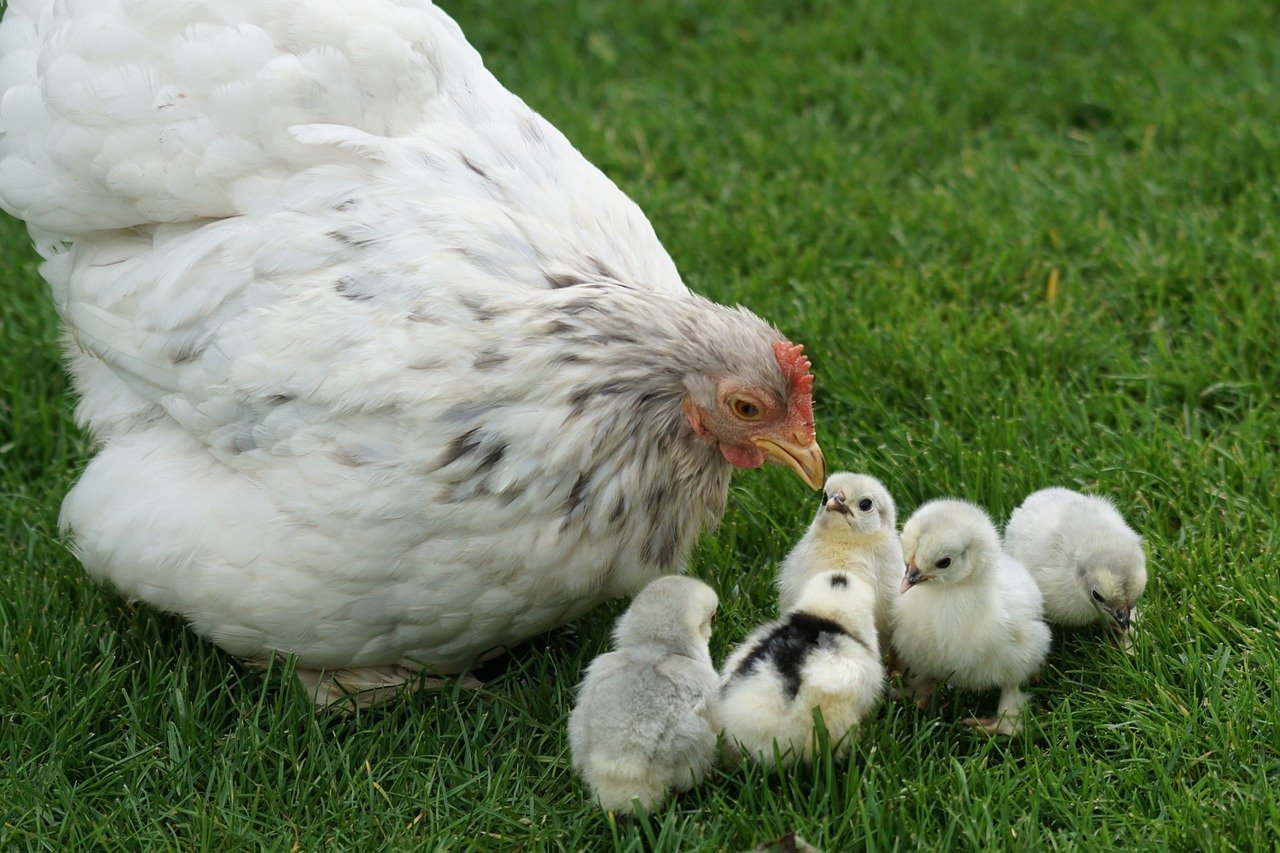If you’re planning to raise chickens, understanding the life cycle of a chicken is important. Chickens go through five main stages throughout their life, from fertilization to adulthood.
So, let’s take a look at what happens at each of these stages. It can help you understand how to raise your chickens throughout every change in their lives.
Stages of the Life Cycle of a Chicken
There are five main stages to a chicken’s lifespan, and each one is important for how the bird grows and develops. Let’s look at what happens as chickens grow and age.
Stage 1: Fertilization
The chicken life cycle begins before the chicken is born. It starts with a rooster fertilizing a hen’s eggs. If you want baby chicks to hatch, you’ll need to introduce a rooster to your flock.
While mating, roosters will try to court the hens to make themselves seem like the best roosters in the flock. The hens will choose their mates carefully by paying attention to things like looks, leadership qualities, attentiveness, and food finding skills.
Usually, the healthiest rooster will win hens over. Yet, roosters will make an attempt to impress hens by finding food and bringing it to them. They will also initiate a courtship dance if interested in mating, but the hens will ignore them if they don’t reciprocate the feelings.
Mating usually only takes about a minute, and then the birds will go on about their normal lives. Then, when the hen lays eggs, the fertilized eggs may result in beautiful baby chicks.
Stage 2: Egg Embryo
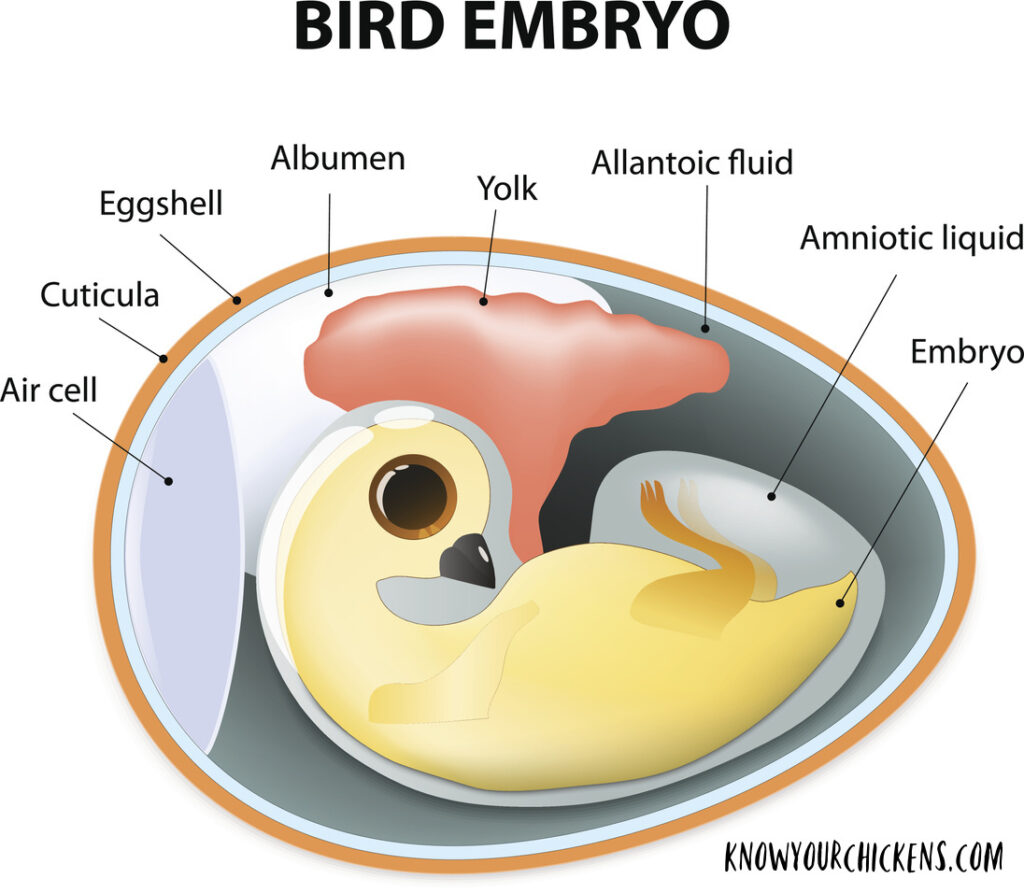
The embryo stage of a chicken’s life begins once a hen lays an egg. Hens can lay two types of eggs after mating: fertile and infertile. Most eggs will be fertilized, causing them to hatch into tiny chicks.
Broody hens will sit on their eggs to help them hatch, but if your hens are uninterested in keeping the eggs warm, you might need to purchase an incubator.
It takes 21 days for the embryo to develop inside the egg, and unique changes occur during every day of the process. The timelines can vary slightly between each egg and embryo.
Daily Cycle of an Embryo
- Day 1: The germinal disc and tissue develops.
- Day 2: Blood circulation begins and the heart develops.
- Day 3: The heart starts beating and blood vessels are visible.
- Day 4: Some limbs begin to form, and the amniotic sac develops.
- Day 5: Elbows and knees become visible.
- Day 6: The chick’s beak and toes begin to form.
- Day 7: The beak continues to grow, and the comb develops.
- Day 8: Feathers start to appear and the ear canals open.
- Day 9: Claws begin to form, and the embryo starts to look chicken-like.
- Day 10: Claws finish forming and egg teeth develop.
- Day 11: The tail feathers grow in.
- Day 12: The feet and legs further develop while feathers become more visible.
- Day 13: Light feathers cover the chick’s body and scales appear on their legs.
- Day 14: The chick turns in the egg so their head is facing the larger end of the egg.
- Day 15: The chick’s gut develops, and they consume the egg white.
- Day 16: Feathers now cover the chick’s entire body.
- Day 17: The egg white gone, and the chick’s head is between their legs.
- Day 18: The chick fills the entire interior space of the egg, meaning they’re almost ready to hatch.
- Day 19: Almost the whole yolk sac absorbs.
- Day 20: The chick begins using the egg tooth to break through the egg shell from the inside. This process is known as “pipping.”
- Day 21: The chick finally hatches. Hatching usually happens within 18 hours.
Unlike many other births, chicks move along very quickly, developing new organs and body parts each day. It’s amazing how much can happen in such a short amount of time.
It’s possible for chicks to hatch a few days early or late, but it could affect their health. If chicks are close to hatching, leave them be and let them break out of the shell on their own.
Stage 3: Chick
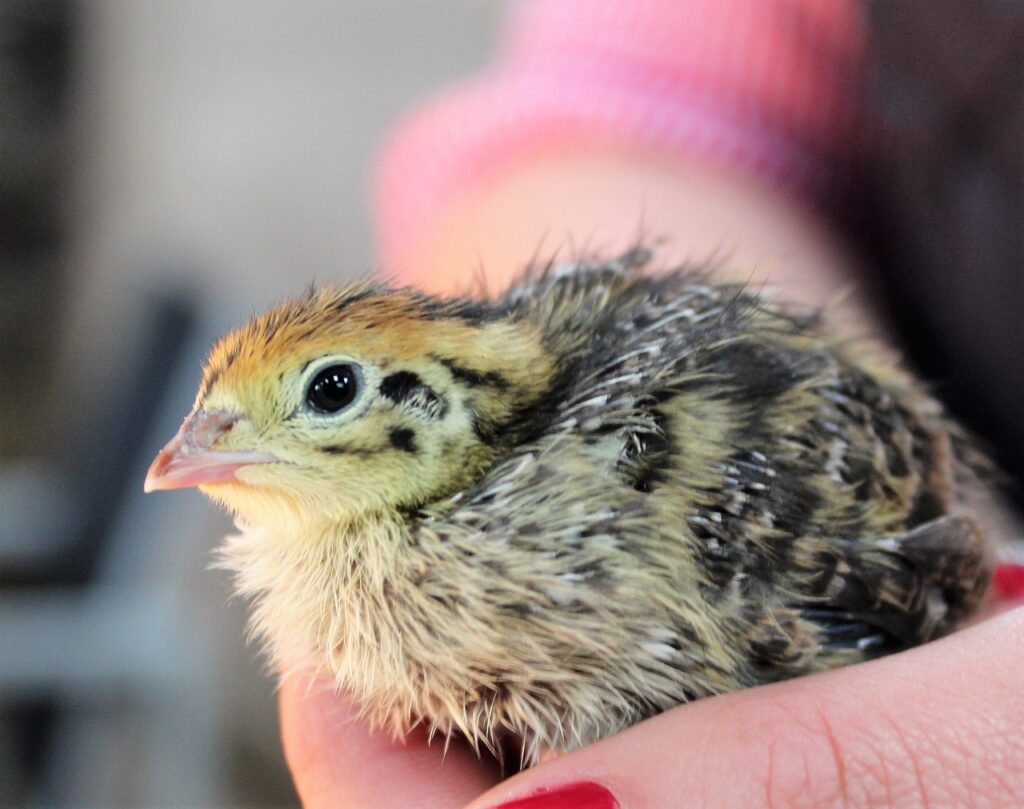
The next stage in the life cycle of a chicken is the chick after it hatches from the egg. Chicks will come out of their eggs with wet “down” feathers. It doesn’t take long for them to dry off and become the fluffy little chicks you normally see.
When the chick is dry and fluffy, you should move them to a brooder area, which is an indoor room that’s warmed up using an infrared lamp. Chicks will spend their first few weeks in that space.
Provide the chicks in the brooder area with food and water. Chicks should get food that’s high in protein, vitamins, and minerals to help them grow at a healthy pace. All chicken breeds grow at different rates, so be sure to research your chicks’ specific breed.
How Fast Do Chicks Grow?
Most chicks start developing real feathers at five days old, and they gain improved bone development after 12 days. Chicks will likely have most of their real feathers by 18 days old, and they should start to look like their breed after 30 days.
Chicks can start spending time outside as early as 8 weeks old, but it depends on the breed. In general, chicks should stay in the brooder area until their full feathers have developed.
Cornish Crosses are one of the fastest developing chicken breeds, with chicks maturing at around 8 weeks old. At that age, they will already weigh 8 to 10 pounds. However, slower developing chickens, like the Rhode Island Red, will only be one pound at 6 weeks old.
Stage 4: Pullet
“Pullet” is another word for a teenager chicken. Those teenage years vary based on the breed, but most chickens are pullets when they reach 6 to 8 weeks old. They’re noticeably smaller than adult chickens, and they have patchy feathers.
This is an awkward stage for chickens since they’re much bigger than chicks, but they don’t yet have the beautiful appearance of an adult chicken. Most breeds don’t develop sexual differences until they’re pullets. Most keepers use the hens for egg production while the roosters are sold or used for meat.
Introducing pullets to adult chickens should be a slow process. Since pullets are smaller, they’re likely to get bullied by the bigger birds. In their teenage years, chickens will start to assert themselves to decide where they fall on the hierarchy.
They might peck at each other to assert dominance, but it’s best not to interfere unless it becomes overly violent and blood is drawn. The “pecking order” is a natural way that chickens establish where they fall in the flock.
Stage 5: Adult
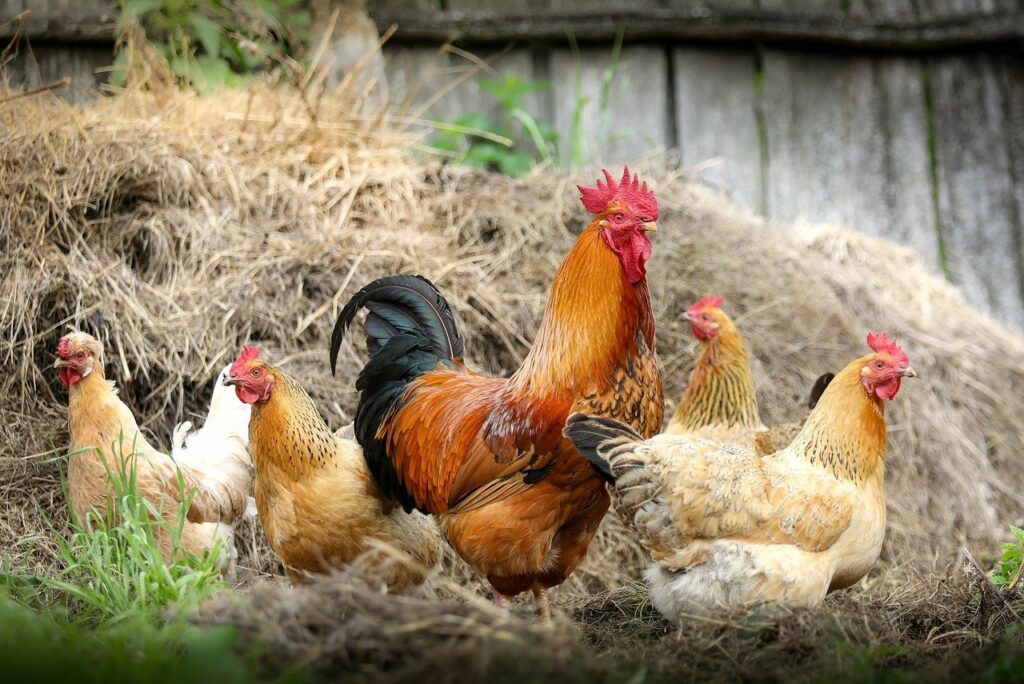
This is the final stage of the life cycle of a chicken. Some hens may start laying eggs during the pullet stage, but their eggs will be much smaller than usual. Those first eggs are sort of like a “test round,” and their later eggs will be much larger and healthier.
The definition of when a pullet becomes a hen is unclear, but many say that once a pullet lays an egg, she’s considered a hen. Some also say that any chickens under a year old are a pullet. Either way, hens have a much more mature appearance than pullets. Males also become roosters around the same time.
Adult hens will lay more eggs than usual when they’re young. They may lay an egg almost daily for the first two years of their lives. Then, they will likely take a break whenever they molt their feathers and grow fresh ones.
Egg laying becomes less regular as chickens age. The amount of eggs they lay per year varies based on breed and health. Yet, if they stop laying eggs altogether, it could be a sign that they’re sick.
As chickens change from pullets to hens, it’s a good idea to switch to a layer feed. Layer feed has a little less protein, but it’s still high in essential nutrients like calcium. That way, it’ll ensure that your chickens’ eggs are healthy.
How Long Do Chickens Live?
Most chickens live between 3 and 8 years, but that can vary greatly depending on the breed. Health, genetics, and care have a huge impact on a chicken’s lifespan.
As your chickens age, you might notice them losing color in their legs, beaks, and wattles. Those could be signs that your hens are nearing the end of their lives.
Challenges of Raising Chickens
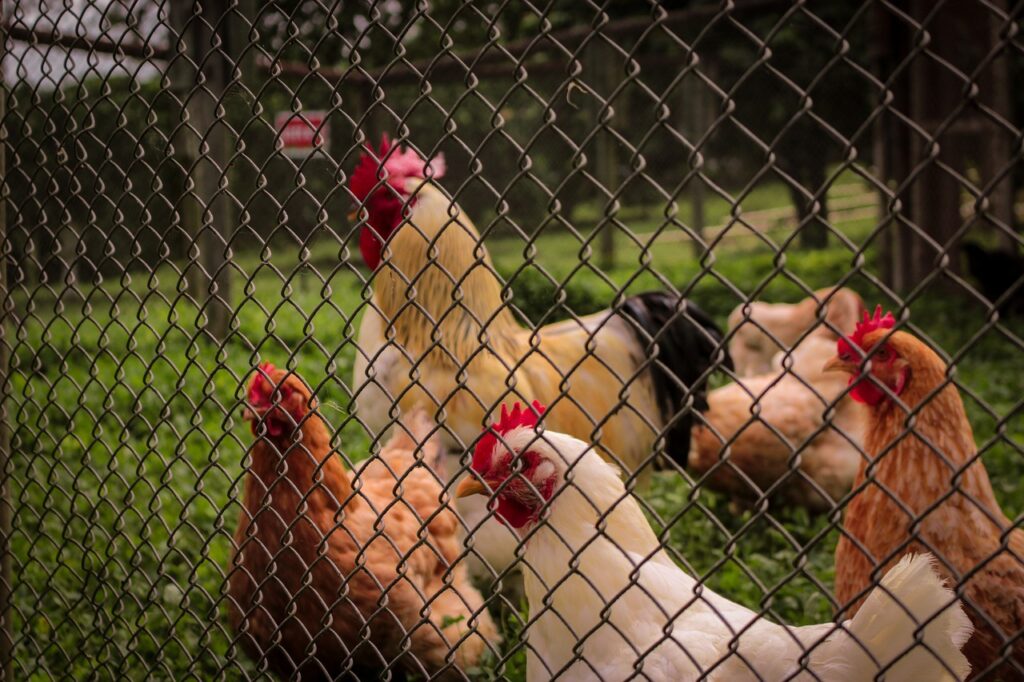
Keeping chickens healthy is easier said than done. Some chicks die shortly after hatching, and it usually has to do with infections, genetics, or incubator problems. So, make sure you’re only breeding healthy birds together and providing your chicks with proper care.
Luckily, most chicks will survive as long as they have no major health issues. However, it’s possible for them to catch diseases and infections, even as adults. The best way to prevent that is to clean their space regularly and take them in for health checkups.
Most chickens today are bred specifically for egg production. However, that high rate of production can cause them to not live as long. So, if you want your chickens to live long, healthy lifespans, find chickens bred for dual purposes. You’ll still get plenty of eggs, but your hens will likely live longer.
Final Thoughts
The life cycle of a chicken might not be as long as some other animals, but it has many details and steps. From the moment a chicken and rooster mate, the egg develops and the chick quickly gets essential organs and body parts.
It’s amazing to watch a chicken grow and develop, but that can’t happen without proper care. Make sure your chickens have all the essential care requirements through every stage of their lives. That way, they’ll live long and produce many healthy eggs for you to use.
